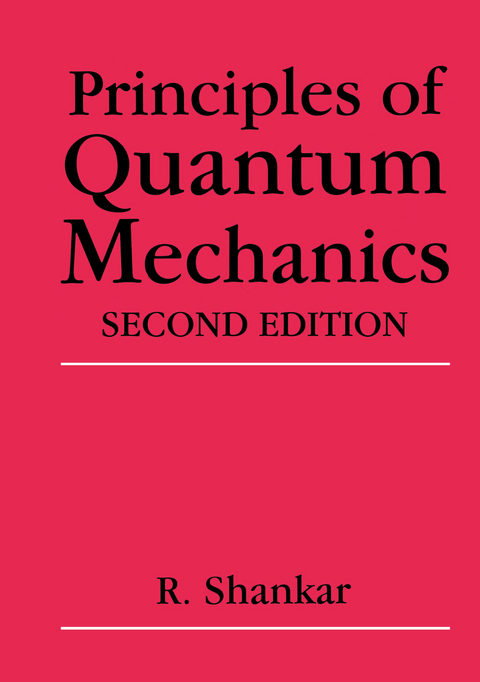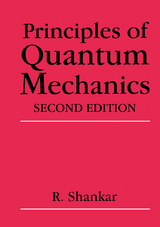Principles of Quantum Mechanics
Kluwer Academic/Plenum Publishers (Verlag)
978-0-306-44790-7 (ISBN)
R. Shankar has introduced major additions and updated key presentations in this second edition of Principles of Quantum Mechanics. New features of this innovative text include an entirely rewritten mathematical introduction, a discussion of Time-reversal invariance, and extensive coverage of a variety of path integrals and their applications. Additional highlights include:
- Clear, accessible treatment of underlying mathematics
- A review of Newtonian, Lagrangian, and Hamiltonian mechanics
- Student understanding of quantum theory is enhanced by separate treatment of mathematical theorems and physical postulates
- Unsurpassed coverage of path integrals and their relevance in contemporary physics
The requisite text for advanced undergraduate- and graduate-level students, Principles of Quantum Mechanics, Second Edition is fully referenced and is supported by many exercises and solutions. The book’s self-contained chapters also make it suitable for independent study as well as for courses in applied disciplines.
1. Mathematical Introduction.- 1.1. Linear Vector Spaces: Basics.- 1.2. Inner Product Spaces.- 1.3. Dual Spaces and the Dirac Notation.- 1.4. Subspaces.- 1.5. Linear Operators.- 1.6. Matrix Elements of Linear Operators.- 1.7. Active and Passive Transformations.- 1.8. The Eigenvalue Problem.- 1.9. Functions of Operators and Related Concepts.- 1.10. Generalization to Infinite Dimensions.- 2. Review of Classical Mechanics.- 2.1. The Principle of Least Action and Lagrangian Mechanics.- 2.2. The Electromagnetic Lagrangian.- 2.3. The Two-Body Problem.- 2.4. How Smart Is a Particle?.- 2.5. The Hamiltonian Formalism.- 2.6. The Electromagnetic Force in the Hamiltonian Scheme.- 2.7. Cyclic Coordinates, Poisson Brackets, and Canonical Transformations.- 2.8. Symmetries and Their Consequences.- 3. All Is Not Well with Classical Mechanics.- 3.1. Particles and Waves in Classical Physics.- 3.2. An Experiment with Waves and Particles (Classical).- 3.3. The Double-Slit Experiment with Light.- 3.4. Matter Waves (de Broglie Waves).- 3.5. Conclusions.- 4. The Postulates—a General Discussion.- 4.1. The Postulates.- 4.2. Discussion of Postulates I -III.- 4.3. The Schrödinger Equation (Dotting Your i’s and Crossing your ?’s).- 5. Simple Problems in One Dimension.- 5.1. The Free Particle.- 5.2. The Particle in a Box.- 5.3. The Continuity Equation for Probability.- 5.4. The Single-Step Potential: a Problem in Scattering.- 5.5. The Double-Slit Experiment.- 5.6. Some Theorems.- 6. The Classical Limit.- 7. The Harmonic Oscillator.- 7.1. Why Study the Harmonic Oscillator?.- 7.2. Review of the Classical Oscillator.- 7.3. Quantization of the Oscillator (Coordinate Basis).- 7.4. The Oscillator in the Energy Basis.- 7.5. Passage from the Energy Basis to the X Basis.- 8. The Path Integral Formulation of Quantum Theory.- 8.1. The Path Integral Recipe.- 8.2. Analysis of the Recipe.- 8.3. An Approximation to U(t) for the Free Particle.- 8.4. Path Integral Evaluation of the Free-Particle Propagator.- 8.5. Equivalence to the Schrödinger Equation.- 8.6. Potentials of the Form V=a + bx + cx2 + d? + ex?.- 9. The Heisenberg Uncertainty Relations.- 9.1. Introduction.- 9.2. Derivation of the Uncertainty Relations.- 9.3. The Minimum Uncertainty Packet.- 9.4. Applications of the Uncertainty Principle.- 9.5. The Energy-Time Uncertainty Relation.- 10. Systems with N Degrees of Freedom.- 10.1. N Particles in One Dimension.- 10.2. More Particles in More Dimensions.- 10.3. Identical Particles.- 11. Symmetries and Their Consequences.- 11.1. Overview.- 11.2. Translational Invariance in Quantum Theory.- 11.3. Time Translational Invariance.- 11.4. Parity Invariance.- 11.5. Time-Reversal Symmetry.- 12. Rotational Invariance and Angular Momentum.- 12.1. Translations in Two Dimensions.- 12.2. Rotations in Two Dimensions.- 12.3. The Eigenvalue Problem of Lz.- 12.4. Angular Momentum in Three Dimensions.- 12.5. The Eigenvalue Problem of L2 and Lz.- 12.6. Solution of Rotationally Invariant Problems.- 13. TheHydrogen Atom.- 13.1. The Eigenvalue Problem.- 13.2. The Degeneracy of the Hydrogen Spectrum.- 13.3. Numerical Estimates and Comparison with Experiment.- 13.4. Multielectron Atoms and the Periodic Table.- 14. Spin.- 14.1. Introduction.- 14.2. What is the Nature of Spin?.- 14.3. Kinematics of Spin.- 14.4. Spin Dynamics.- 14.5. Return of Orbital Degrees of Freedom.- 15. Addition of Angular Momenta.- 15.1. A Simple Example.- 15.2. The General Problem.- 15.3. Irreducible Tensor Operators.- 15.4. Explanation of Some “Accidental” Degeneracies.- 16. Variational and WKB Methods.- 16.1. The Variational Method.- 16.2. The Wentzel-Kramers-Brillouin Method.- 17. Time-Independent Perturbation Theory.- 17.1. The Formalism.- 17.2. Some Examples.- 17.3. Degenerate Perturbation Theory.- 18. Time-Dependent Perturbation Theory.- 18.1. The Problem.- 18.2. First-Order Perturbation Theory.- 18.3. Higher Orders in Perturbation Theory.- 18.4. A General Discussion of Electromagnetic Interactions.- 18.5. Interaction of Atoms with Electromagnetic Radiation.- 19. Scattering Theory.- 19.1. Introduction.- 19.2. Recapitulation of One-Dimensional Scattering and Overview.- 19.3. The Born Approximation (Time-Dependent Description).- 19.4. Born Again (The Time-Independent Approximation).- 19.5. The Partial Wave Expansion.- 19.6. Two-Particle Scattering.- 20. The Dirac Equation.- 20.1. The Free-Particle Dirac Equation.- 20.2. Electromagnetic Interaction of the Dirac Particle.- 20.3. More on Relativistic Quantum Mechanics.- 21. Path Integrals—II.- 21.1. Derivation of the Path Integral.- 21.2. Imaginary Time Formalism.- 21.3. Spin and Fermion Path Integrals.- 21.4. Summary.- A.l. Matrix Inversion.- A.2. Gaussian Integrals.- A.3. Complex Numbers.
| Erscheint lt. Verlag | 16.3.2011 |
|---|---|
| Zusatzinfo | 116 Illustrations, black and white; XVIII, 676 p. 116 illus. |
| Verlagsort | New York |
| Sprache | englisch |
| Maße | 178 x 254 mm |
| Themenwelt | Mathematik / Informatik ► Mathematik ► Angewandte Mathematik |
| Naturwissenschaften ► Physik / Astronomie ► Astronomie / Astrophysik | |
| Naturwissenschaften ► Physik / Astronomie ► Mechanik | |
| Naturwissenschaften ► Physik / Astronomie ► Quantenphysik | |
| Naturwissenschaften ► Physik / Astronomie ► Theoretische Physik | |
| ISBN-10 | 0-306-44790-8 / 0306447908 |
| ISBN-13 | 978-0-306-44790-7 / 9780306447907 |
| Zustand | Neuware |
| Haben Sie eine Frage zum Produkt? |
aus dem Bereich




